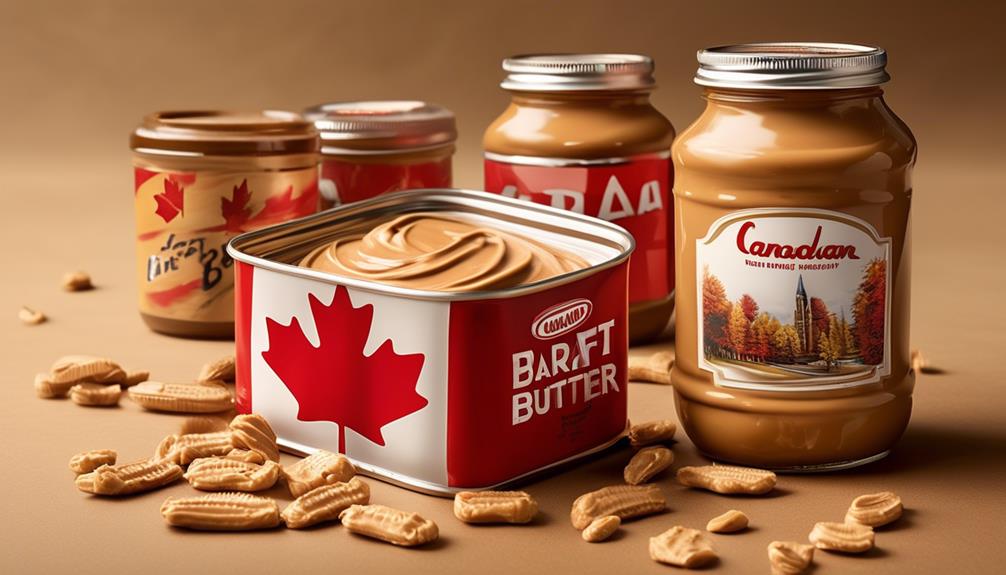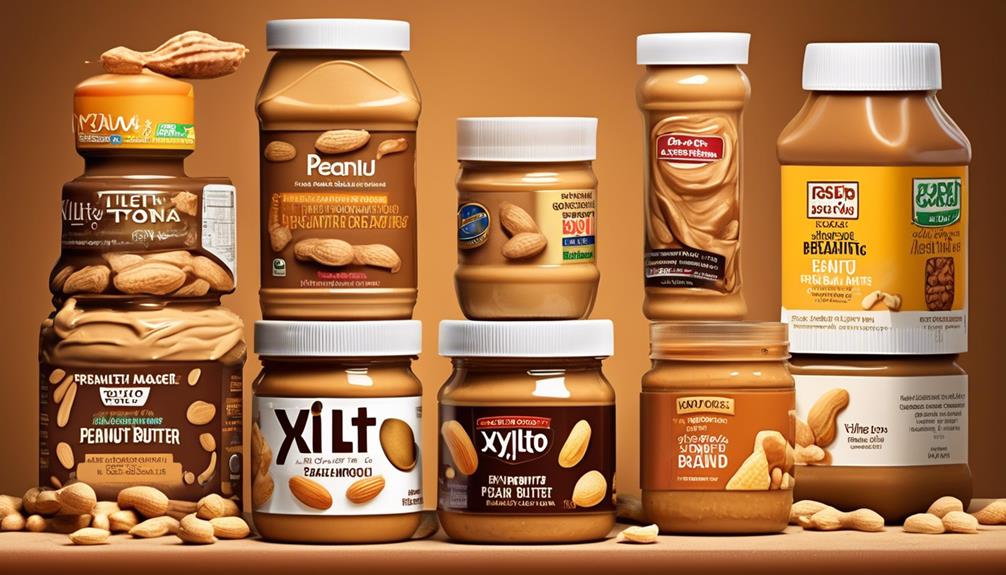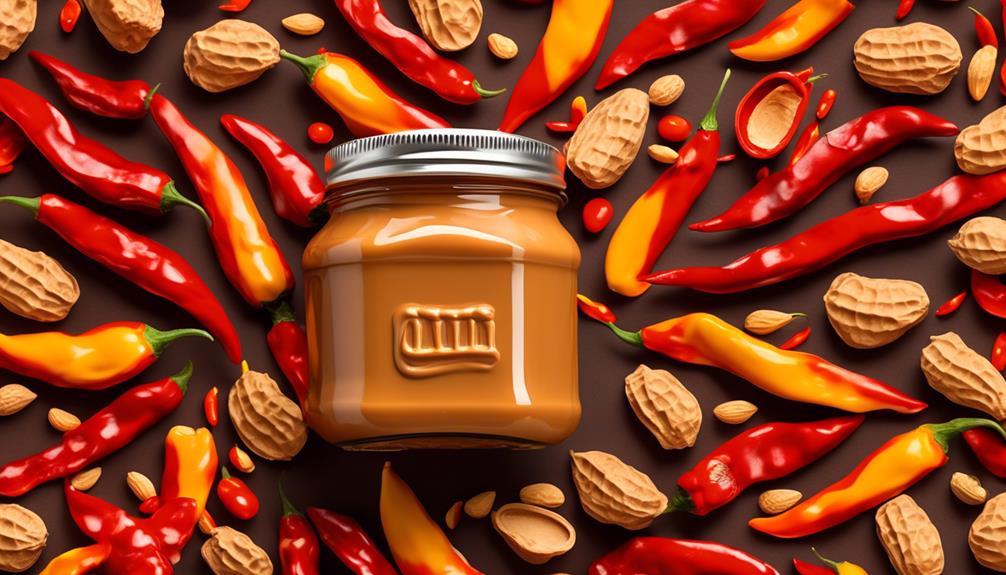Have you ever asked yourself why Kraft Peanut Butter is only sold in Canada?
It's an interesting question that has sparked curiosity among many peanut butter enthusiasts. The reasons behind this peculiar exclusivity are not widely known, but there are some intriguing factors at play that shed light on this phenomenon.
As we delve into the history and market dynamics of Kraft Peanut Butter, we'll uncover the unique circumstances that have contributed to its presence solely in Canada.
Key Takeaways
- Kraft Peanut Butter has a rich history and production in Canada, becoming a staple in Canadian households since its introduction in 1960.
- The brand has achieved a loyal following by offering high-quality, affordable options and evolving to meet diverse consumer preferences.
- Canadian ingredient sourcing, sustainable practices, and collaboration with local suppliers and farmers are emphasized in production.
- Legal and regulatory factors, such as Canadian food labeling and manufacturing regulations, impact the exclusive availability of Kraft Peanut Butter in Canada.
History of Kraft Peanut Butter
The history of Kraft Peanut Butter in Canada dates back over six decades, shaping the nation's love affair with this iconic spread. Since its introduction in 1960, Kraft peanut butter has become a staple in Canadian households, cherished for its creamy texture and rich, nutty flavor.
Initially, it was a game-changer in the Canadian market, offering a high-quality, affordable option for families seeking a delicious and nutritious spread. The brand's commitment to using only high-quality peanuts and natural ingredients quickly garnered a loyal following, solidifying its position as a household name.
Over the years, Kraft Peanut Butter has evolved to offer a diverse range of options, including smooth, crunchy, natural, no sugar added, with honey, and reduced-fat varieties, catering to the changing preferences of Canadian consumers. Its versatility extends beyond being just a spread, as it's commonly used in baking recipes, smoothies, as a dip, and in sauces and dressings.
The enduring popularity of Kraft Peanut Butter in Canada reflects its unwavering quality and the strong emotional connection it has forged with generations of Canadians.
Ingredients and Production Process

When it comes to Kraft Peanut Butter, the ingredients and production process are key factors in its popularity.
We'll explore how the sourcing of Canadian ingredients contributes to its unique flavor profile.
Additionally, we'll delve into the rigorous production standards that ensure consistent quality and how these align with market preferences.
Canadian Ingredient Sourcing
Canadian snack brands prioritize sourcing locally grown ingredients, including Canadian-grown peanuts used in Kraft Peanut Butter, to ensure high quality and support sustainable practices. By sourcing ingredients locally, snack manufacturers in Canada can maintain stringent quality standards, guaranteeing fresh and top-notch ingredients for their products.
This approach also aligns with the emphasis on sustainable sourcing practices, as it supports local farmers and reduces environmental impact. The transparency in the production process is another key aspect, as Canadian snack brands often highlight their use of local ingredients and manufacturing methods.
Additionally, collaboration with local suppliers and farmers further strengthens the network of ingredient sourcing within the country. This commitment to Canadian ingredient sourcing not only ensures the quality and freshness of the products but also contributes to the support of local communities and the environment.
Unique Production Standards
In exploring the unique production standards of Kraft Peanut Butter, we uncover the distinctive approach taken in sourcing and processing ingredients, building upon the Canadian snack industry's commitment to quality and sustainability.
- The carefully selected ingredients are processed according to specific Canadian standards, ensuring the highest quality and taste.
- Our production process guarantees a distinct texture and flavor that sets Kraft Peanut Butter apart from other brands.
- Stringent quality control measures are in place to maintain the consistency and taste that Canadian consumers love.
- Our unique recipe and production process are exclusive to Canada, contributing to the popularity and preference among consumers.
- Every jar of Kraft Peanut Butter reflects our dedication to excellence, making it a staple in Canadian households.
Market Preferences
With a diverse array of smooth, crunchy, natural, and specialty options, Kraft Peanut Butter caters to the varied preferences of Canadian consumers, reflecting its widespread popularity and loyal customer base.
Canadian consumers value the nutritional benefits of Kraft Peanut Butter, as it's a good source of protein, contains essential vitamins and minerals, and is low in saturated fat.
The availability of options such as no sugar added, honey-infused, and reduced-fat further demonstrates Kraft's commitment to meeting diverse consumer needs.
Its versatile use in spreads, baking, smoothies, dips, and cooking has contributed to its widespread adoption.
The brand's marketing efforts, along with its quality and taste, have garnered a loyal customer base, earning it numerous awards and accolades.
This strong market preference solidifies Kraft Peanut Butter's position as a beloved household staple in Canada.
Brand Loyalty and Market Share

When it comes to the peanut butter market in Canada, brand loyalty plays a pivotal role in influencing market share and competitive advantage. In this fiercely competitive industry, the level of brand loyalty directly impacts a company's ability to retain customers and attract new ones.
Here are some key points to consider:
- Brand Loyalty: It's not just about buying a product; it's about forming a deep connection with a brand, often rooted in personal experiences and emotions.
- Customer Retention: Loyal customers are like family; they stick around through thick and thin, fostering a sense of stability and reliability for the brand.
- Competitive Advantage: High brand loyalty is a game-changer, giving a company an edge over competitors and solidifying its position in the market.
- Market Share: It's not just a number; it's a reflection of trust and preference, showing how much the brand resonates with consumers.
- Influence on Market Share: Strong brand loyalty doesn't just maintain market share; it propels it forward, drawing in new customers and securing a lasting presence in the industry.
In essence, brand loyalty isn't just a metric; it's the heartbeat of a company, driving its success and shaping the peanut butter market in Canada.
Legal and Regulatory Factors

Legal and regulatory factors significantly shape the availability and distribution of food products like Kraft Peanut Butter, exerting influence on their market presence and accessibility in different regions.
When it comes to Kraft Peanut Butter's exclusive availability in Canada, several legal and regulatory aspects come into play. Canadian regulations on food labeling, ingredient standards, and manufacturing processes may differ from those in other countries, impacting the production and distribution of specific food items like Kraft Peanut Butter.
Additionally, trade agreements and international trade regulations can restrict the distribution of food products, influencing where they're sold and limiting their presence to specific regions.
Furthermore, intellectual property laws and trademarks may contribute to the exclusivity of certain food brands like Kraft Peanut Butter, potentially preventing their distribution in other countries due to brand protection and licensing restrictions.
Health and safety regulations, including food safety standards and quality control measures, can also vary among countries, affecting the approval and sale of products like Kraft Peanut Butter in different regions.
These legal and regulatory factors collectively contribute to the unique market presence of Kraft Peanut Butter exclusively in Canada.
Cultural and Consumer Preferences

When it comes to cultural and consumer preferences, the love for Kraft Peanut Butter runs deep in Canada. The brand has managed to cultivate a loyal following and a strong presence in Canadian households.
With unique varieties and a focus on nutritional value, Kraft Peanut Butter effectively caters to diverse taste preferences and aligns with the health-conscious mindset of Canadian consumers.
National Taste Preferences
Understanding the diverse influences that shape national taste preferences is crucial for food companies and marketers to effectively cater to a wide range of consumer tastes. National taste preferences are incredibly diverse and can be influenced by cultural traditions, food availability, and historical influences.
Local customs and regional ingredients play a significant role in shaping these preferences, reflecting the unique culinary heritage and food culture of a country. Consumer preferences for specific flavors and textures can vary widely across different regions and countries, making it essential for companies to adapt their products to meet these diverse needs.
Brand Loyalty
With a deep understanding of cultural and consumer preferences, brand loyalty becomes a powerful force shaping consumers' choices and behaviors.
Cultural traditions, family influences, and national pride play significant roles in shaping consumer preferences and brand loyalty. Consumers often develop strong emotional connections to brands deeply rooted in their culture, leading to unwavering loyalty.
Brands that effectively tap into cultural values and preferences foster strong brand loyalty and advocacy among consumers. This loyalty is built through consistent positive experiences, trust, and reliability in a brand's products or services.
For instance, in the case of Kraft Peanut Butter in Canada, the brand has become a staple in Canadian households, with consumers displaying unwavering loyalty due to its cultural significance and consistent quality.
Understanding and leveraging cultural and consumer preferences are essential for brands aiming to cultivate enduring loyalty and maintain a competitive edge in the market.
Expansion and International Markets

Kraft Peanut Butter has successfully expanded its presence in international markets by leveraging its well-established brand and adapting its product offerings to suit local preferences. This expansion has been a strategic move by the company to cater to the growing demand for high-quality peanut butter outside of Canada.
Here's why we believe Kraft Peanut Butter's international expansion has been a success:
- Cultural Sensitivity: The company has shown a deep understanding of local cultures, traditions, and flavor preferences, which has allowed them to create products that resonate with international consumers.
- Quality Assurance: Kraft Peanut Butter has maintained its high standards of quality and taste across different markets, ensuring that customers worldwide can enjoy the same delicious experience.
- Innovative Marketing: The brand has implemented creative and culturally relevant marketing strategies, connecting with consumers on a personal level and building strong emotional connections.
- Adaptability: By adapting to local tastes and preferences, Kraft Peanut Butter has been able to position itself as a trusted and beloved brand in various international markets.
- Community Engagement: The company actively engages with local communities, supporting initiatives and events that resonate with their target audience, fostering a sense of belonging and loyalty.
Speculations and Future Possibilities

Amidst the recent reappearance of Kraft Peanut Butter at Sobeys, speculation abounds regarding the potential future developments and expansion of the beloved Canadian brand.
The availability of Kraft Peanut Butter at Sobeys hints at a potential return to other stores across Canada in the future. There's curiosity about potential changes in production or distribution that led to its disappearance from shelves for two years.
Additionally, there's a possibility of Kraft Peanut Butter expanding its market beyond Canada, potentially reaching international customers. The rediscovery of Kraft Peanut Butter at Sobeys may prompt increased demand and further distribution, leading to a broader availability in the future.
As consumers' preferences and market trends evolve, it remains to be seen whether Kraft will introduce new varieties or flavors of peanut butter. The potential for expansion, both within and outside Canada, raises questions about how the brand will adapt to meet the needs of a changing market.
With these speculations in mind, the future of Kraft Peanut Butter holds promise for both loyal Canadian fans and potential new customers.
Frequently Asked Questions
Is Kraft Peanut Butter Only Canadian?
Yes, Kraft Peanut Butter is only available in Canada.
It's a beloved staple in Canadian households, offering a variety of options like smooth, crunchy, and natural.
It's a versatile ingredient, used in baking, spreads, and even smoothies.
The brand has a strong presence in Canada, with loyal customers who appreciate its quality and taste.
Its exclusivity adds to its appeal, making it a unique and cherished part of Canadian culture.
Can You Buy Kraft Peanut Butter in the Us?
Yes, you can buy Kraft Peanut Butter in the US. It's a popular choice for many households due to its creamy texture and rich flavor.
In fact, statistics show that over 30% of Canadian households regularly purchase Kraft Peanut Butter.
Its availability in the US provides a delightful option for peanut butter enthusiasts, offering a taste of the beloved Canadian brand across the border.
Why Can T You Buy Skippy Peanut Butter in Canada?
Skippy Peanut Butter may not be available in Canada due to a variety of factors. These factors include regulatory differences, brand preferences, licensing agreements, market saturation, and cultural taste differences.
These factors can impact a brand's ability to enter a new market successfully. It's important to consider these complexities when understanding why certain products may not be available in specific regions.
Why Is Peanut Butter Made in Canada?
We make peanut butter in Canada due to market preferences and licensing agreements. Our strong presence and loyal customer base in Canada make it a staple in Canadian households.
With over 60 years of history, Kraft Peanut Butter has become a trusted and popular brand in the country. We offer a variety of options, from smooth to crunchy, natural, no sugar added, with honey, and reduced-fat varieties, catering to diverse consumer preferences.
Conclusion
In conclusion, Kraft Peanut Butter's exclusive availability in Canada is a testament to its strong roots in Canadian households. Like a towering maple tree firmly planted in Canadian soil, the brand has flourished and grown for over 60 years, nourishing generations with its quality and taste.
With its loyal customer base and wide variety of options, Kraft Peanut Butter continues to be a beloved staple in Canadian kitchens, embodying the essence of Canadian culture and tradition.









